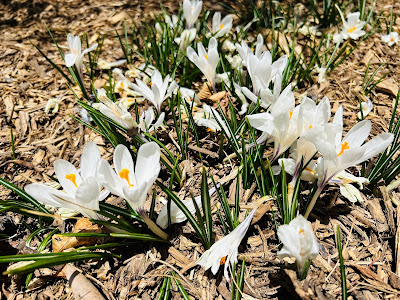Crocuses are part of the Iris family and contain nearly a hundred species Worldwide with many additional hybrid cultivars popular in gardens everywhere. These are low growing plants whose flower stems remain below ground. Depending upon the species they may bloom in autumn or spring, with some spring varieties blooming as early as January. The blooms close up at night as well as on overcast days, preferring sunshine for blooming. Crocus grow from seeds or from daughter cormels found on the corm that will ultimately produce the mature plant. Corms are short, vertical underground stems. These often swollen stems are reservoirs for storing water and nutrients during winter or other adverse weather conditions like drought. After blooming the plant becomes dormant waiting for the right time to bloom again. The autumn blooming crocus, referred to as crocus sativus, are different than our more familiar spring blooming variety. It is ONLY this species of crocus that the spice saffron is derived from.
 |
| Image credit: Johan Puisais. |
Homer paid homage to the crocus in his famous book the Iliad. “Sunrise drew her crocus-like scarf over the sea to bring light to Gods and man alike.” This is likely a description inspired from the vibrant yellowish hue of the bloom from which the name crocus is thought to originate. The Latin word “crocatus” means bright, saffron yellow. The Greek word Krokos also translates to mean yellowish. According to Greek mythology Crocus was a friend to the god Hermes. One day as they played a game of discus Hermes accidentally struck Crocus in the head killing his friend. At the spot where Crocus died a flower of delicate beauty grew. Three drops of Crocus’ blood fell on the flower and these became the stigmata of the flower. Since then, the flower has been called Crocus and the stigmata, saffron.
Crocuses are native to parts of Africa, the Middle east, and Asia. They were first introduced to the Netherlands by the Holy Roman Empire, where now crocus bulbs is the 6th largest in terms of production and exportation. Iran produces 65% of the Worlds saffron, but the highest quality saffron is produced in Krokos, Greece. Saffron is considered the most expensive spice in the World, mostly due to its labor intensive cultivation. The gathering of stigmas from each plant is done by hand, as is all preparation for sale. It is illegal to use modern equipment to harvest saffron. 205 tons of saffron is produced Worldwide annually. It takes 180,000 stigmas from 60,000 flowers to produce 2.2 pounds of saffron which sells for $10,000 US!
In Ancient Egypt saffron was greatly valued not only as a dye, but an ingredient in perfume. Saffron perfume was mixed with tallow or olive oil; at night, saffron threads would be scattered on pillows and sheets for freshness. The crocus flower was not cultivated in ancient Egypt, saffron was consequently imported from Crete, and probably from other empires of the Near East when Egypt was not at war with them. Ironically, as expensive and rare as saffron was, it was abundant in all levels of society; excavations discovered the use of saffron perfume even amongst the laborers who built Merneptah’s tomb. The properties of saffron as a dye were also utilized during embalming rituals. Until the reign of Ramses III and the beginning of the New Kingdom, the final layer of the painstaking mummification process would be a shroud dyed in saffron.
In modern times saffron is known to have many medicinal qualities. The fall blooming varieties are referred to as calchium and contain a chemical called colchicine that is being used in a drug to treat gout. This same variety is also known for its antioxidant benefits and may help fight cell damage and cancer. Other chemicals found in Crocus sativus help fight Parkinson’s disease, Alzheimer’s, depression and treat seizure disorders and even suppress your appetite and help you lose weight. Saffron is also added as a delicious and decadent spice to a wide variety of Asian and Middle Eastern dishes or just to liven up a bowl of rice. While there are many species of crocus, and a wide variety that can be grown in our own yards and gardens, it is only Crocus sativus that contains the properties to treat various medical maladies as well as provide us with saffron. All other crocus varieties should be considered inedible and lacking in the right properties to benefit us medically.
Planting crocus in your yard will not only brighten your landscape, but also provide an early nectar source for hungry bumble bees and other pollinators that have overwintered in a state of dormancy. You may even catch a sleepy bee curled up in the bloom for a restful night’s sleep. Crocus symbolize happiness, cheer and new beginnings, this coincides perfectly with their appearance in late winter or early spring when we are all anxious for sunshine, warmer days and the greening up of a dreary landscape. Spotting the bright purple or yellow crocus shining brightly on a drab background is sure to bring a smile to your face and faith to your heart that warmer days are on the horizon.





No comments:
Post a Comment